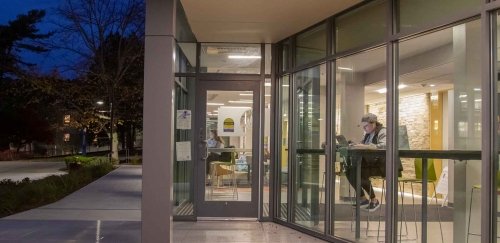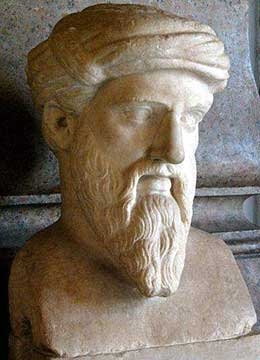The Illuminated Walkway, a Sixth-Century Mystic and the Number Nine
- News & Events
- News
- The Illuminated Walkway, a Sixth-Century Mystic and the Number Nine

Pythagoras, Greek mystic, mathematician and “father of numerology,” would raise an interested eyebrow if he knew that RIC’s Illuminated Walkway was unveiled on the ninth day of the ninth month in the ninth year of the third millennium.

Mapped in the shape of a nine, the Illuminated Walkway was the brainchild of RIC President Nancy Carriuolo, the ninth president, inaugurated in November of the 2008–09 academic year.
Pythagoras was the first to devise the system of numerology. He noted that everything in the world is made up of numbers and that each number has its own vibrational energy. According to numerologists, the number 9 signals both the end of a cycle and a new beginning. Note that the visual depiction of the Arabic “9” spirals in on itself to indicate the completion of a cycle, but with that closure, comes renewal, regeneration, revitalization.
The walkway unveiling will begin Wednesday, Sept. 9, at 9 p.m. at the Murray Center located in the Quad. President Carriuolo has invited members of the campus community and donors of the project to walk the circular portion of the figure-nine route with her. She said the Illuminated Walkway was one of many initiatives that fulfilled one of her presidential themes: to maintain a safe campus. The project was paid for from monies raised for her inauguration last year.
“The college has a very good safety record,” Carriuolo said, “but we need to look at places where we’re vulnerable, for example, our parking lots at night.”
Carriuolo focused on strategies that would increase the visibility of walkways, building entrances, exits and parking lots throughout the campus. She held discussions with Vice President for Administration and Finance Ivy Locke. The guiding principle was to improve pedestrian safety and security, especially in places that feel remote from the campus core.
Eventually, the Illuminated Walkway was born: a paved, well-lit walkway with strategically placed blue light emergency phones. The Walkway is also a way to link buildings on the main campus to buildings on the east campus. The east campus consolidates administrative services. The main campus is mostly comprised of residence halls, classrooms and academic departments. The Illuminated Walkway will bridge the physical and perceptual distance between the two sides of the campus. All in all, the walkway embodies a unified vision that has engendered the enthusiasm of the college community.
“Before the president’s initiative, the lights in the parking lot behind the residence halls didn’t work properly and the cameras were of poor quality. The fence was also in disrepair,” said Teresa Brown, director of Residential Life and Housing.
In fact, poor lighting had been linked to periodic car break-ins. Since the installation of blue light emergency phones with state-of-the-art cameras adjacent to parking lots and buildings, there has been a noticeable decrease in car break-ins, said Deputy Frederick Ghio, former FBI agent and now assistant director of the Office of Security and Safety.
Ghio recounted the car burglaries that occurred two years ago: “A gang hit RIC, PC and the Providence Place Mall before they were caught,” he said. “These organized gangs will saturate an area. It happens on all college campuses and in all open areas.”
Victimization by an organized gang is one thing, but the problem of the lone wolf who enters the residence hall lots by way of Triggs Golf Course is another.
“They usually hit around the time RIC students are going home for spring break,” Ghio said, “or when students are leaving for the summer. They know that the students are going to pack their cars with their belongings the night before they leave. These individuals can get into a car faster than I can get in with my key.”
Ghio emphasized the need for students to take responsibility for their safety. “The best deterrent to a car burglary is to not leave valuables in the car. These people aren’t stealing the cars, they’re stealing the items left in the car,” he said.
And should there be an emergency, students can now quickly make use of the nearest blue light emergency phone.
“It’s very easy to use,” Ghio said. “All of the phones are numbered. When someone picks up the phone and hits the emergency button, the campus police can tell by the number that comes in, which blue phone was activated. Cameras operated in the Office of Security and Safety can also be trained on the location.”
There’s been a doubling of blue light phones, Ghio said, and there will be a considerable increase in cameras as well. New phones with a PA system (an early warning system) are also being installed. In the event of an emergency, the president will be able to address the entire campus community.
Now, in the evening, parking lots and pathways are awash in ethereal cobalt blue light emitted by the emergency phones. Equipped with cameras, they stand like ever-watchful sentinels throughout the campus.
“President Carriuolo was the catalyst for this,” Ghio said. “It would not have happened if it hadn’t been for her. All the safety measures the president is taking shows parents and students that the campus is a safe place, and at night they can rest assured that they have a totally illuminated walkway. We already have a safe campus. The president is making sure it stays safe.”
“I’m a pragmatist,” Carriuolo said. “As the world changes, public safety will become more and more of an issue. We need to be prepared. This is something that needed to be done.”
But Pythagoras would say nothing in the universe happens by chance. He’d say numbers have vibrational frequencies that attract certain energy like a magnet. Hence, an illuminated walkway in the shape of a nine may well be a portent that RIC is poised to take a turn in time toward regeneration, renewal and revitalization. To maintain the good vibrations, this column was written in exactly 999 words.
